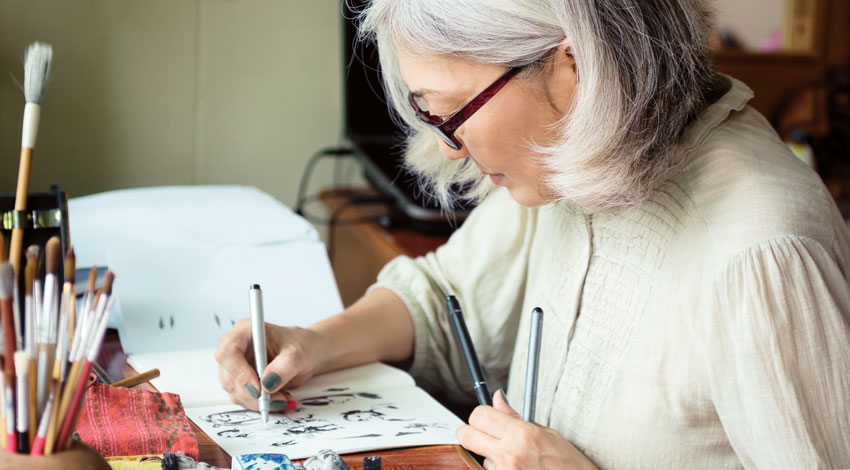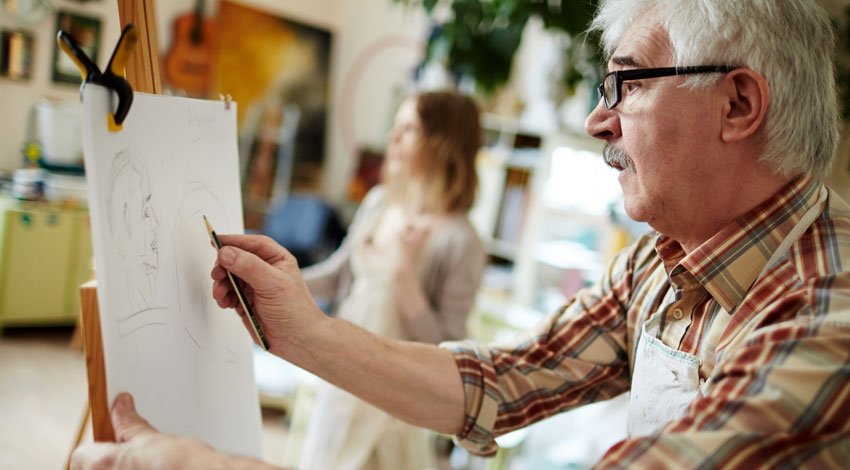Why Draw? A Look at How Drawing Benefits Your Brain
In Road Scholar At Home adventures, Mark Richard Keane leads programs that focus on drawing architecture and structures. Here he tells us that, besides building skills, drawing can benefit your brain too.
Drawing can enhance memory and is found to be a reliable, replicable means of boosting performance. Drawing enhances the learning of individual words. Drawing improves memory by promoting the integration of the elaborative pictorial and motor codes, facilitating measurable gains in performance in aging individuals.

To transfer a word into a drawn visual representation, one must elaborate on its meaning and semantic features, engage in the actual hand movements needed for drawing — at the same time visually inspecting the created picture. This facilitates the retrieval of the studied words.
The human hand was made to draw, and drawing is a fundamental component of the learning and communication experience. Our hands comprise most of the nerve endings of our bodies as well as the highest numbers of muscles. Drawing creates loops of thinking and places in our brain with many input-output paths. We can absorb information by listening or by seeing and reading words. But drawing brings out the multi-modal reinforcement and allows our brain to use that input in a new way.

Those who draw:
1. Have active brain cells.
The right hemisphere of your brain is responsible for creativity and imagination, while the left hemisphere is involved in logical tasks. As you draw, 80% of your right hemisphere gets activated. When you are drawing, not only do both hemispheres work simultaneously, but they develop their capacities as well.
2. Have sharp memory.
Drawing and painting help grow new brain cells by adding synapses to the brain’s transmitters, leaving experiences reserved in your brain stronger, more striking and more accessible.
3. Are more observant and can concentrate better.
As Leonardo da Vinci once said, “Painting embraces all the 10 functions of the eyes, that is to say, darkness, light, body and color, shape and location, distance and closeness, motion and rest.” Through such concentration, you can “see” details around you, your surroundings and your environment.
4. Are better at communicating.
Through drawing, you can express various emotions, trains of thought and collective feelings. You can express what you feel, what you want and even your perception. Shy people and people with verbal disabilities often find drawing an easier form of communication.
5. Release depression through drawing.
Drawing is an art with a healing power. It produces positive brain chemistry like serotonin, endorphins, dopamine and norepinephrine.
6. Have strong motor skills.
Many parents introduce children to drawing at a very tender age, even before they can hold pencils properly. Children develop stronger motor skills because they are manipulating and gripping different devices like pencils, charcoals or brushes with their hands. Their working capacity improves — and therefore, for the adults, their motor skills increase.
7. Have improved self-esteem.
If you draw something and you like it, you may want to hang the art on the wall. This provides satisfaction that stimulates you to move forward.
8. Reduce their stress through drawing, because it is relaxing and a fruitful distraction from everyday chores.
9. Often express themselves in a unique manner and may have a different take on the world.
10. Have fun.
All you need is a paper, a pencil. Draw something, unwrap yourself, stimulate your brain cells and boost your energy!

Mark Richard Keane
Drawing:
- Improves your memory
- Reduces anxiety
- Increases happiness
- Eases physical pain
- Makes you more resilient
- Improves concentration
- Makes you more creative
We retain:
- 10% of what we read
- 20% of what we hear
- 30% of what we see
- 50% of what we see and hear
- 70% of what we discuss with others
- 80% of what we personally experience
- 95% of what we draw
Interested in learning to draw with Road Scholar? Peruse our offerings on our website.
Have thoughts? Join the conversation — and the community — on Facebook.
